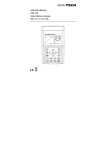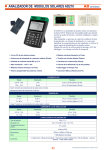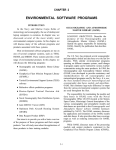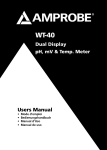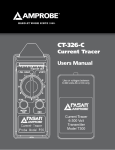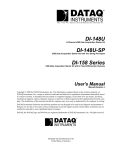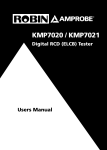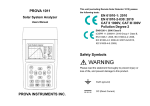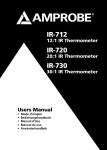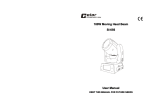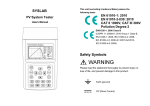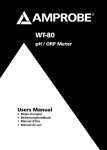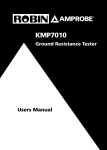Download SOLAR-600
Transcript
SOLAR-600 Solar Analyzer Users Manual • • • • Mode d’emploi Bedienungshandbuch Manual d’Uso Manual de uso SOLAR-600 Solar Analyzer English Users Manual May 2010, Rev.1 ©2010 Amprobe Test Tools. All rights reserved. Printed in Taiwan Limited Warranty and Limitation of Liability Your Amprobe product will be free from defects in material and workmanship for 1 year from the date of purchase. This warranty does not cover fuses, disposable batteries or damage from accident, neglect, misuse, alteration, contamination, or abnormal conditions of operation or handling. Resellers are not authorized to extend any other warranty on Amprobe’s behalf. To obtain service during the warranty period, return the product with proof of purchase to an authorized Amprobe Test Tools Service Center or to an Amprobe dealer or distributor. See Repair Section for details. THIS WARRANTY IS YOUR ONLY REMEDY. ALL OTHER WARRANTIES - WHETHER EXPRESS, IMPLIED OR STAUTORY INCLUDING IMPLIED WARRANTIES OF FITNESS FOR A PARTICULAR PURPOSE OR MERCHANTABILITY, ARE HEREBY DISCLAIMED. MANUFACTURER SHALL NOT BE LIABLE FOR ANY SPECIAL, INDIRECT, INCIDENTAL OR CONSEQUENTIAL DAMAGES OR LOSSES, ARISING FROM ANY CAUSE OR THEORY. Since some states or countries do not allow the exclusion or limitation of an implied warranty or of incidental or consequential damages, this limitation of liability may not apply to you. Repair All test tools returned for warranty or non-warranty repair or for calibration should be accompanied by the following: your name, company’s name, address, telephone number, and proof of purchase. Additionally, please include a brief description of the problem or the service requested and include the test leads with the meter. Non-warranty repair or replacement charges should be remitted in the form of a check, a money order, credit card with expiration date, or a purchase order made payable to Amprobe® Test Tools. In-Warranty Repairs and Replacement – All Countries Please read the warranty statement and check your battery before requesting repair. During the warranty period any defective test tool can be returned to your Amprobe® Test Tools distributor for an exchange for the same or like product. Please check the “Where to Buy” section on www. amprobe.com for a list of distributors near you. Additionally, in the United States and Canada InWarranty repair and replacement units can also be sent to a Amprobe® Test Tools Service Center (see address below). Non-Warranty Repairs and Replacement – US and Canada Non-warranty repairs in the United States and Canada should be sent to a Amprobe® Test Tools Service Center. Call Amprobe® Test Tools or inquire at your point of purchase for current repair and replacement rates. In USA In Canada Amprobe Test Tools Amprobe Test Tools Everett, WA 98203 Mississauga, ON L4Z 1X9 Tel: 877-AMPROBE (267-7623) Tel: 905-890-7600 Non-Warranty Repairs and Replacement – Europe European non-warranty units can be replaced by your Amprobe® Test Tools distributor for a nominalv charge. Please check the “Where to Buy” section on www.amprobe.com for a list of distributors near you. European Correspondence Address* Amprobe® Test Tools Europe In den Engematten 14 79286 Glottertal, Germany Tel.: +49 (0) 7684 8009 - 0 *(Correspondence only – no repair or replacement available from this address. European customers please contact your distributor.) SOLAR-600 Solar Analyzer A) Front Panel 11 12 9 13 10 14 1 15 2 16 3 17 4 18 5 19 6 20 7 8 SOLAR-600 Solar Analyzer 1) F1Button: (Reserved) 2) F2 Button: (Reserved) 3) ZERO CAL Zero calibration of voltage and current. Connect (short) the two Kelvin clips together and press this button. Regular calibration of zero would maintain the accuracy of the instruments. 4) 12) 13) 5) I/V/P Select Button Select display of I-V/ V-I curve, P-V/P-I curve, or both curves 6) 14) 7) 15) 16) Auto Scan Button 9) LCD LCD displays measurement data and curves 10) Setup Button Enter/Exit SETUP menu 11) Button (1) In a curve, press it to move the cursor left (2) In SETUP menu, press it to decrement value by 1 End Button Stop scanning point (current) setting 17) Rec Button (1) Record the present measurement data (2) How to clear recorded data: keep pressing REC button and turn on the analyzer, then all the data recorded in the analyzer will be deleted Scan Button Auto scan I-V curve test Begin Button Start scanning point (current) setting Manual scan I-V curve test based upon specified value 8) Button (1) In a curve, press it to move the cursor right (2) In SETUP menu, press it to increment value by 1 Test Button Single point I-V test based up specified value Button In the SETUP menu, press q button to select next item (Buzzer) Button Press this button to turn on/off the beeper (low Power) alarm function Button In the SETUP menu, press p button to select previous item 18) Graph Grid Button Display/Cancel graph grid 19) I/V Curve Button Select I or V as horizontal coordinate 20) Power Button Turn on/off the power of Solar Analyzer SOLAR-600 Solar Analyzer B) Rear Panel 1) Communication Window To connect Solar Analyzer with PC via USB cable 2) Stand 1 5 3) Battery Cover 4) Screw of battery cover 5) AC to DC adaptor input 2 3 4 C) TOP Panel (Connectors) 1 2 1) V+ Terminal 2 ) I+ Terminal 3) V- Terminal 4) I- Terminal 3 4 SOLAR-600 Solar Analyzer CONTENTS SYMBOLS, WARNINGS AND PREPARATION......................................................... 2 UNPACKING AND INSPECTION............................................................................. 3 INTRODUCTION..................................................................................................... 4 OPERATION............................................................................................................ 7 Selected Condition of Auto Scan, Manual Scan, or Test................................. 8 Connecting Diagram......................................................................................... 10 Auto Scan.......................................................................................................... 11 Manual Scan...................................................................................................... 12 Single Point Test................................................................................................ 13 Data Logging..................................................................................................... 14 Zero Calibration................................................................................................ 15 Clear recorded testing data.............................................................................. 16 SPECIFICATION....................................................................................................... 18 Electrical Specifications..................................................................................... 18 Electrical Specification...................................................................................... 29 MAINTENANCE AND REPAIR................................................................................ 20 Fuse Replacement ........................................................................................... 21 Maintenance & Cleaning ................................................................................ 22 PC CONNECTION, SOFTWARE INSTALLATION AND OPERATION........................ 23 INTROODUCTION.................................................................................................. 23 Operating Environment.................................................................................... 23 Hardware........................................................................................................... 23 Connecting Procedures..................................................................................... 23 SOFTWARE INSTALLATION 24............................................................................. 24 Install Software................................................................................................. 24 Install USB Driver............................................................................................... 24 SOFTWARE OPERATION........................................................................................ 25 Start Executing Program................................................................................... 25 Working Window before Communication...................................................... 25 Working Window after Communication......................................................... 26 Communication................................................................................................. 26 Tool Bar . ........................................................................................................... 27 Information, Parameter, Overall.......................................................................... 29 1 SYMBOLS, WARNINGS AND PREPARATION Symbols and Warnings: Please read the statement thoroughly to prevent injury or loss of life, and prevent damage to this product. � Caution: 1. The ventilation openings on the unit should not be blocked. 2. Please pay attention to polarity of DC input, follow the polarity info by the input jack. � Caution, Risk of Electric Shock � This equipment is not for measurements performed for CAT II, III, and IV � Please remove all the test leads before performing maintenance, cleaning, battery replacement, fuse replacement, etc � Earth (Ground) � DC--Direct Current � Conforms to relevant Australian standards � Complies with European Directives Do not dispose of this clamp meter as unsorted municipal waste. Contact a qualified recycler for disposal �WARNING! Do not operate this instrument in the presence of gasoline, natural gas, propane, or in other combustible atmospheres. 2 Unpacking and Inspection Your shipping carton should include: 1 1 Carrying Bag SOLAR 600 Solar Analyzer 1 Users Manual 1 AC Adaptor 1 RS232C (to USB Bridge) Cable 1 Rechargeable Lithium Battery Pack 1 Software CD 1 Software Manual 1 Kelvin Clips (12A max, 1 pair) If any of the items are damaged or missing, return the complete package to the place of purchase for an exchange. FEATURES • I-V Curve Test for solar module. • 60V and 12A Capability. • Maximum Solar Power (Pmax) search by auto-scan. • Maximum Voltage (Vmaxp) at Pmax. • Maximum Current (Imaxp) at Pmax. • Voltage at open circuit (Vopen). • Current at short circuit (Ishort). • I-V curve with cursor. • Data logging function to analyze solar power characteristics over a period of time. • Efficiency (%) calculation of solar panel. • Scan delay setting. (0 ~ 3000 mS) • Solar panel area setting. (0.001 m2 ~ 9999 m2) • Standard light source setting. (10 W/m2 ~ 1000 W/m2) • Min. power setting for alarm function. • Built-in Calendar Clock. • Rechargeable lithium battery with built-in charging circuit. • Optical USB cable for PC. 3 INTRODUCTION The SOLAR-500 can be used in Quality Control for Production Line, Warehouse or Site of Installation. Manufacturers of solar panels can test the characteristics for quality control purpose in the production line. Due to the advantage of portability of the unit, quality inspectors can randomly pick samples of solar panels and test them in the warehouse to assure quality before shipment. Installation engineer can randomly test samples of solar panels at site to verify the quality of solar panels used at site of installation. Example A: Identify the Solar Power System Requirement Measure the actual maximum power (Pmax), voltage (Vmaxp), and current (Imaxp) at maximum power. Instead of using the rated maximum power, the system designer needs to be aware of the actual solar power from the solar panel under actual operating condition. So designer can actual know how many pieces of solar panels are required to generate specific power. The voltage and current under actual operating condition (in the morning, at noon, and in the afternoon) are required for system designer to design the optimal charging system, so most of the solar power can be absorbed and stored in the battery. Users can test the characteristics of solar panel at different time of day and store the data. Then design can know if the solar system can generate appropriate power at any time. 4 Example B: Maintenance of Solar Panels Abnormal I-V Curve (Cells at the corner of solar panel are defected) 5 Abnormal I-V Curve (defected cells scattered over the solar panel) The technicians or maintenance engineers can store the characteristics data of solar panels in the beginning. And compare the characteristics data in the weekly, monthly or yearly maintenance. If the characteristics of any solar panels are different from the previous data, technicians or maintenance engineers can further identify the problems of solar panels. For example, if any cells of solar panels are damaged, the I-V curve would be very different from a typical curve. If the solar panels are covers by a lot of dust, the I-V curve or the maximum power would be much lower than previously stored data. Once defected panels are found, technicians or maintenance engineers can replace them with new panels Example C: Verify the Best Installation Angle of Solar Panels Engineers can collect data of installation angle at different date and time by using the unit at site of installation. The data can be used as reference to design automated angle adjustment system. Or the data can be used to select an optimal angle for a fixed angle installation. 6 OPERATION �WARNING! when users see “Overheated” warning shown in LCD 1.Users must wait during this “Overheated: cooling” period before they start next simulation. 2.And if users would like to turn the unit off, they must wait for another 3 min. (at least) for the cooling fan to cool off the internal components. �WARNING! When using a lithium battery as the power source, please do not plug in an AC adaptor. Or the power source will be stopped and the data will disappear Note: When pressing any button, users will hear a sound of buzzer. When keeping pressing it for more than 2 seconds, users will hear another sound of buzzer 7 Selected Condition of Auto Scan, Manual Scan, or Test Users should first select AUTO SCAN ( characteristics of a solar panel. ) to obtain a general idea of button to turn on the Analyzer. Properly connect the pair of 1. Press Kelvin clips to the solar panel and the Analyzer. The red Kelvin clip is for positive pole and the black Kelvin clip for negative pole. button to start AUTO SCAN. After the scanning is finished, 2. Press the result will come out like below. Afterward, if users are interested in a specific operating range, they can enter the beginning and ending values of scan in the setup menu. Press SCAN ( ) button to test the specific range. 1. Press button to turn on the Analyzer. Properly connect the pair of Kelvin clips to the solar panel and the Analyzer. The red Kelvin clip is for positive pole and the black Kelvin clip for negative pole. 2. Press button to enter the SETUP menu: (Type in the current range for scanning) Current Range of Scan begin: 200mA Current Range of Scan end: 548mA After setting up the current range, press SETUP menu. button again to exit the Note: If the “Current Range of Scan begin” is over “Ishort”, then the scanning will not be performed and no result will come out. 8 3. Press button to start MANUAL SCAN. After the scanning is finished, the result will come out like below. If users are interested in a specific point of test current, users can enter ) to test the the current value for a Single Test Point. Press TEST ( characteristics at the current. button to turn on the Analyzer. Properly connect the pair of 1. Press Kelvin clips to the solar panel and the Analyzer. The red Kelvin clip is for positive pole and the black Kelvin clip for negative pole. 2. Press button to enter the SETUP menu: (Type in the testing current) Single Test Point: 609mA After setting up the current range, press SETUP menu. button again to exit the 3. Press button to start Testing a Single Test. After the testing is finished, theresult will come out like below. The result (P, V, I) is shown in reverse video as below. 9 Connecting Diagram Kelvin Clip Connecting Diagram Alligator Clip Connecting Diagram 10 Auto Scan 1. Press button to turn on the Analyzer. 2. Properly connect the pair of Kelvin clips to the solar panel and the Analyzer. The red Kelvin clip is for positive pole and the black Kelvin clip for negative pole. (refer to above Connecting Diagram). 3.Turn on any available light source (e.g. halogen lamp, xenon lamp, tungsten lamp, …) and let it illuminates solar panel uniformly. Or place the solar panel under the sun. (AUTO SCAN) button to perform Auto-scan. After the 4. Press scanning is finished, the result will come out like below. 5. The unit automatically measures the followings parameters: Vopen, Ishort, Pmax, Vmaxp, and Imaxp. Based upon those parameters, the unit run simulation and draw I-V / V-I curve and P-V / P-I curves in LCD. 6. Users can move the cursor to review each individual values along the curve. �WARNING! There is a time delay before the unit performs the “Auto Scan”. This time delay allows the light source to be turned on before “Auto Scan” starts. Time delay can be set in the SETUP menu Note: If the short circuit current (Ishort) exceeds 12A, Auto Scan will not be performed. Please select Manual Scan and limit the ending value of Scan to be less than 12A. 11 Manual Scan 1. Press button to turn on the Analyzer. 2. Properly connect the pair of Kelvin clips to the solar panel and the Analyzer. The red Kelvin clip is for positive pole and the black Kelvin clip for negative pole. button to enter the SETUP menu: (Type in the current range 3. Press for scanning) Current Range of Scan begin: 200mA Current Range of Scan end: 548mA After setting up the current range, press SETUP menu. button again to exit the Note: If the “Current Range of Scan begin” is over “Ishort”, then the scanning will not be performed and no result will come out. 4. Press (SCAN) button to start MANUAL SCAN. The analyzer run simulation from the BEGIN value to END value, and draw I-V / V-I curve and P-V / P-I curve in LCD. Users can move the cursor to review each individual values along the curve. After the scanning is finished, the result will come out like below. �WARNING! There is a time delay before the unit performs the “Manual Scan”. This time delay allows the light source to be turned on before “Manual Scan” starts. Time delay can be set in the SETUP menu. 12 Single Point Test 1. Press button to turn on the Analyzer. 2. Properly connect the pair of Kelvin clips to the solar panel and the Analyzer. The red Kelvin clip is for positive pole and the black Kelvin clip for negative pole. button to enter the SETUP menu: (Type in the current range 3. Press for scanning) Single Test Point: 609mA After setting up the current range, press SETUP menu. button again to exit the 4. Press button to start Testing a Single Test. After the testing is finished, the result will come out like below. The result (P, V, I) is shown in reverse video as below. �WARNING! Time delay in the “Single Point Test” allows the current simulation to last longer. Though the max. value is 9.999 sec., the time delay is changed to 10 msec. if power is over 100 W. The time delay is extended to 3 seconds if power is less than 100 mW. 13 Data Logging Users can perform data logging to record the characteristics of solar power over a period of time (e.g. record data every 60 minutes). 1. Set the sampling time in the SETUP menu. 2. Press the REC button, then AUTO SCAN will be performed and data will be recorded. In the above example, data is collected every 60 minutes. �WARNING! If the sampling time is set to 0 minutes, only 1 set of I-V curve and characteristics data is recorded. �WARNING! Please use the application software provided with the Analyzer to read the saved testing results. (refer to the Software Manual) 14 Zero Calibration Calibration of voltage and current zero would improve the accuracy of the instrument before usage. Connect (short) the two Kelvin clips together and press and hold the button. A message of “ZERO CAL…” is shown in LCD. Release the button when the message disappears. Regular calibration of zero would maintain the accuracy of the instruments. 15 Clear recorded testing data Users can clear the recorded testing data in the Analyzer. The procedures of deleting saved data: 1. Keep pressing (REC) button and turn on the Analyzer (i.e. press button ) at the same time. 2. After turning on the Analyzer, all the data recorded in the Analyzer (memory) will be deleted. When the buzzer beeps twice, it means the record data is already cleared. �WARNING! After performing this CLEAR function, all the recorded data in Analyzer (memory) will be deleted completely and can not be restored. If it is necessary to keep the testing data, please use the Application Software to download and save them before deleting them from the Analyzer. (refer to the Software Manual) Setup Menu 1. Press 2. Press (SETUP) button to enter the Parameter Setting screen. or buttons to select the setting items. 16 (1) Time delay before scan. This delay allows light source to illuminate the solar panel before scan stars. (2) Sampling time of data logging (0 to 99 minutes) (3) Current Range of Scan begin. The beginning value of current for scan to start. (4) Current Range of Scan end. The ending value of current for scan to stop. (5) Area of Solar Cell or Panel. Based upon the input area and irradiance, this unit can calculate the solar power converting efficiency (6) Irradiance. Light intensity in W/m2. (7) Single Test Point. Users can enter a specific value of current here. When users press the TEST button, this specific value of current will be simulated and result will be shown. (8) Alarm of Low Power. If the maximum power is lower than this value, then a beep sound will be heard. 3. Press Press or or buttons to select the setting items. buttons to change the setting values, or press them for few seconds to promptly change setting values. 4. After setting Parameters, press button to exit SETUP menu. 17 SPECIFICATION Electrical Specifications (23°C ±5°C, Four-wire Measurement) DC Voltage Measurement Range Resolution Accuracy 0 ~ 10 V 0.001 V ± 1 % ± (1 % of Vopen ± 0.1 V) 10 ~ 60 V 0.01 V ± 1 % ± (1 % of Vopen ± 0.1 V) Vopen: open circuit voltage of solar cell or module. If users use alligator clips to measure voltage only (I+ clip is not connected), clips (V- and I-) must be shorted together. Thus, 4-wire measurement is converted to 2-wire measurement. DC Current Measurement Range Resolution Accuracy 0.01 ~ 10 A 1 mA ± 1 % ± (1 % of Ishort ± 9 mA) 10 ~ 12 A 10 mA ± 1 % ± (1 % of Ishort ± 0.09A) Ishort: short circuit current of solar cell or module. Circuit resistance is compensated in the AUTO SCAN. Ishort is measured at zero circuit resistance. Circuit resistance is not compensated in the Manual Scan or Single Point Test. DC Current Simulation Range Resolution Accuracy 0.01 ~ 10 A 1 mA ± 1 % ± 9 mA 10 ~ 12 A 10 mA ± 1 % ± 0.09A If current is greater than 12A, test (Auto-Scan, Scan, or Test) can not be performed. 18 Electrical Specifications (23°C ±5°C, Four-wire Measurement) Battery Type Rechargeable Lithium Battery, 11.1Vdc, 3400mAh Battery Life 400 times of linear scan from 60V to 0V and 0A to 12A Data Logging Memory Size 99 records AC Adaptor AC 110V or 220V input DC 15V / 1~3A output Dimension 257(L) x 155(W) x 57(H) mm (10.12 x 6.1 x 2.24 inch) Weight 1160g / 40.0oz (Batteries included) Operation Environment 0°C to 50°C (32°F to 122°F), 85% RH Temperature Coefficient 0.1% of full scale / °C (<18°C or >28°C) Storage Environment -20°C to 60°C (-4°F to 140°F), 75% RH Accessories User Manual x 1, AC adaptor x 1 Optical USB Cable x 1 Rechargeable lithium battery pack x 1 Software CD x 1, Software Manual x 1 Kelvin Clips (12A max) x 1 set � - EMC: EN 61326-1: 2006 - LVD: EN 61010-1: 2001 This product complies with requirements of the flowing European Community Directive: 2004/108/EC (Electromagnetic Compatibility) and 2006/95/EC (Low Voltage). However, electrical noise or intense electromagnetic fields in the vicinity of the equipment may disturb the measurement circuit. Measuring instruments will also respond to unwanted signals that may be present within the measurement circuit. Users should exercise care and take appropriate precautions to avoid misleading results when making measurements in the presence of electronic interference. 19 MAINTENANCE AND REPAIR If the lithium battery can not be charged, users should always purchase a new lithium battery from the distributor. The charging circuit built-in is designed only for the lithium battery included. Only AMPROBE® genuine part and Lithium battery pack can be allowed to use on your SOLAR 600. Incorrect battery type and specification could cause damage or hazard on instrument and user. Steps of Battery Replacement 1. Unscrew and remove the battery with cover. 2. Put in a new recharging battery with cover. 3. Screw the battery cover. Please follow the below steps to charge the lithium battery 1. Connect the AC Adaptor with the Solar Module Analyzer. 2. Turn on the Solar Module Analyzer. 3. During recharging (takes 10 hours), the % of power is shown 100%. 4. After recharging, remove the AC Adaptor and LCD displays “Power:100%”. 20 Fuse Replacement When the voltage can not be measured (Vnow = 0V) after properly connecting the Analyzer and the solar panel, please check the fuse. If the fuse is damaged (burned), please replace a new fuse by following the procedures: 1. Turn off the Analyzer and remove all the connecting wires and power sources. 2. Unscrew the battery cover. Disconnect the lithium battery and remove the lithium battery with cover. 3. Unscrew the (4pcs.) screws of the bottom cover. Remove the bottom cover. Remove the power connector connecting the bottom cover and the circuit board (J2). 4. Remove the damaged (burned) fuse. 5. Put in a new fuse of the same specifications (15A / 250V). 6. Connect the power connector. Replace and screw the bottom cover. 7. Replace the lithium battery with cover. Replace and screw the battery cover. Location of Fuse 21 �WARNING! After removing the bottom cover, please do not touch the parts on the circuit board, especially the communication LED. Or the communication function will fail. Maintenance & Cleaning 1. Servicing not covered in this manual should only be performed by qualified personnel. Repairs should only be performed by qualified personnel. 2. Periodically wipe the case and cable with a damp cloth and detergent; do not use abrasives or solvents. 3. Please remove all the batteries if users won’t use the Solar Module Analyzer for a long time. 22 PC Connection, Software Installation And Operation INTROODUCTION Operating Environment • The Software (Application program) should be installed in the operation system of Microsoft Windows Vista / XP / 2000 (SP3). • USB driver program should be installed (the Software will install it automatically). Hardware • Personal Computer (PC): we recommend the processor of Pentium 4 Celeron 1.2GHz or above. • RAM: we recommend 512MB or above. • Screen resolution: requires 1024 x 768 pixels. • Solar Module Analyzer. (“Analyzer” for short in this manual) • USB cable. Connecting Procedures Step 1: Turn on PC and Analyzer. Step 2: Connect USB Cable properly. Step 3: Start the Software of the Analyzer. Step 4: Click “Communication” button . 23 SOFTWARE INSTALLATION Install Software Execute Install.bat (which is in the software disc) to enter the procedures of installing the Software. Please follow the instructions to install the Software. During the installation, the USB driver program and the Analyzer Software will be installed automatically. Remark: 1.After putting the software disc into CD-ROM drive, the Software will automatically execute the installation. 2. If the installation is not automatically executed, please choose the Install.bat program in the software disc to perform the installation. 3. After the Software has been installed, please restart the system. Install USB Driver During the installation of the Software, the USB driver program will be installed automatically. However, if users need to install USB driver program, please choose the USB Driver Directory in the software disc, click CP210xVCPInstaller.exe program (for Windows Vista / XP / 2000) to execute the installation of USB Driver. Remark: 1. If the driver program can’t detect the hardware, please remove the hardware and then plug it in properly. 24 SOFTWARE OPERATION Start Executing Program Click Start -> All Programs -> Solar Module Analyzer 12A, choose “Solar Module Analyzer 12A” or click the shortcut to start executing the Software. Working Window before Communication Communication After clicking “Communication” on the display, the Software will check if the Analyzer is connecting with the PC. When the PC can not locate the Analyzer, the display will show “No ComPort”. Please check if the optical USB cable is well plugged into the PC and if the USB driver is started. (Please check the Control Panel: click Control Panel g System g Hardware.) After the communication is successful, all the functions of the tool bar will be opened for users. Hardcopy The screen display will be hardcopied and printed out by a printer. 3Open Files Files in PC can be opened and read without connecting with the Analyzer. 25 Working Window after Communication There are four main parts in this window: 1. Communication. 2. Tool bar. 3. Information, Parameters and Overall. 4. Message. Communication To get the information of the Analyzer, first make sure the communication between the Analyzer and the PC work well. If the communication with the Analyzer is stopped during operation, the PC will display a warning – “ComPort Close!”, users can always click “Communication” to reconnect the Analyzer. However, if the reconnecting still fails, please restart the Software and the Analyzer. 26 Tool Bar New Recording : Start new recording. Open File : Open and read a file. Save File : Save all the present samples to a file named *.sma_12A Expor t: If users click the top of this function, then all the present records will be exported to a file (in the same format as the last one selected by users) which can be read in EXCEL. (1) by CSV : A single record in the display will be exported to a file (*.CSV) which can be read in EXCEL. (2) by Tab : A single record in the display will be exported to a file (*.Tab) which can be read in EXCEL. (3) All by CSV : All the present records will be exported to a file (*.CSV) which can be read in EXCEL. (4) All by Tab : All the present records will be exported to a file (*.Tab) which can be read in EXCEL. Print : The waveform and figures of the present working window will be printed out via a printer. Time Calibration : The time of the Analyzer will be calibrated per the present time of the PC. LCD Download : The data on the LCD of the Analyzer will be downloaded to the PC. And users can use “Save AS” function to save the LCD data as a BMP file; and use “Print” function to print it out. Recordings Download : The recording data of the Analyzer will be downloaded to the PC. And each recording downloaded from the Analyzer will be included in the recording data of the PC. 27 Clear Records : The recording data of the Analyzer will be cleared. Auto Scan : Let the Analyzer perform “Auto Scan” function, then get the measurement data and include them in the sample record of the PC. Cycle Scan : Users can set up a Cycle Time, and then the Software will perform “Auto Scan” function per it. When this “Cycle Scan” function is used, the Software will close other functions. Please leave Cycle Scan to enable the other functions. Cycle Time : the time period (unit: minute) for performing “Auto Scan”. Exit : leave the “Cycle Scan” to the main screen. Start : start performing “Auto Scan” function. Stop : stop the “Auto Scan” function. (this Stop button will display after pressing “Start”) Scan: Let the Analyzer perform “Scan” function. This “Scan” function has to work with “BEGIN” and “END”, details please refer to the operation manual of the Analyzer. 28 Information, Parameter, Overall A.1 Information Display the curves and data of the measurements. Display the starting time of recording, curves and data. Select display modes of curves: 1. IV: only display IV curve (such like the read line). 2. P: only display W (power) curve (such like the green curve). 3. IV, P: display both IV and W (power) curves. Curve: users can toggle between I:V and V:I for selecting the units of Y and X axes. 1. I:V – I for Y axis, V for X axis. 2. V:I – V for Y axis, I for X axis. Data displayed: When users move the mouse in the curve, the three data (V, I, W) of the Present Sample will display. For example users can see from the above: (here the units of Y and X axes are V:I) 29 1. V (5.659V) in red for Y axis; 2. I (767mA) in white for X axis; 3. W (4.342W) in green. Bedside moving the mouse, users also can use the t and u buttons of the PC keyboard to move the scale. (but it will work only when the cursor of the mouse is located inside the curve.) BEGIN, END, SCAN: When the cursor of the mouse is located inside the waveform, users can click the right button of the mouse to select among “BEGIN”, “END” and “SCAN”. 1. Choose “BEGIN” to set up the current of “SCAN BEGIN” in according to the present current value. 2. Choose “END” to set up the current of “SCAN END” in according to the present current value. 3. Choose “SCAN” to set up the range of “SCAN”. 4. The function of selecting among BEGIN, END and SCAN can not be used if there is no communication between PC and Analyzer. A.2 Detail data f the Present Sample Including Vopen, Ishort, Pmax, Vmaxp, Vmaxp, etc. A.3 The 3 data (V, I, W) of the Present Sample. A.4 Measurement Status and System time 1. The number of the Present record. 2. The total Sample count. 3. The present time and date of the PC. 30 B. IParameter Users can set up the parameters of the Analyzer by typing in values and press “Apply” of each parameter. Users can press “Apply All” button to reset all the parameters of the Analyzer. Or press “Load” button to download the present parameters of the Analyzer. Details of this function please refer toe the operation manual. This function can not be used if there is no communication between the PC and the Analyzer. C. Overall Trend The overall trend is made according to the data of all the samples. 31 Overall Trend: Various figures are displayed in different colors. 1.Mouse the mouse to a certain point of one curve, then this point will become the “Present Sample”. 2.Another way is to use the direction keys of the PC keyboard. Press t button to review last sample; press u button to review next sample; press p or q buttons to other figures of the same sample. The Overall Trend only can display 240 samples (on the bottom it shows the sample range). If users want to review last range (i.e. the last 240 samples) or next range (i.e. the next 240 samples), please move the mouse to one of the green arrows. Detail data of samples: 1.Sample Counts: it shows the total number of all the samples. 2.Present Sample / Date / Time: it shows the number / date / time of the present sample. 3. 5 data (Vopen, Ishort, …) of the Present Sample: There is a blank box next to each figure. Users can tick it to let its curve display; or leave it blank if they don’t want the curve display. 32











































